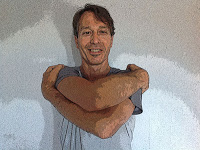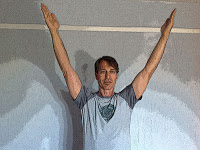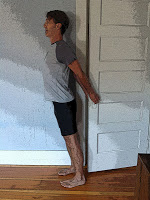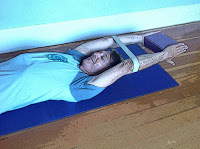
by Baxter and Nina
This sequence was designed to help people with limited shoulder mobility. It allows you to address the limits to movement in the shoulder joints in several directions. For those with tight shoulders, we recommend that you do the poses for 60-90 seconds in order to set the stage for more permanent changes in mobility. We are going to let the pictures do most of the talking, and keep the written instructions to a minimum.
1. Upward Hands Pose with Arms Angled

Upward Hands pose (Urdhva Hastasana) is a very common pose in all levels of practice, and is required for both Sun and Moon Salutations, so it is a good one to practice and, if necessary, modify, as shown here. The idea is to bring your arms slowly out to the sides and up and stop when you feel pain, significant stiffness or if the elbows start to bend. Do all the good stuff you would normally do in Mountain pose, and let it feel like the outer shoulder blades lift faster than the inner shoulder blades toward your arm bones.
2. Eagle Pose Arms Variation

This is one of the several good ways to work towards full Eagle pose arms. Try to reach around the sides of your upper arm bones, not over the top of your shoulders. Hold on where ever you can. Lift your elbows to parallel with floor, and push them slightly forward to create a stretch of the muscles located between the shoulder blades. You can invite your breath into that area to experience more stretch. Be sure to repeat the pose on the opposite side.
3. Half Eagle Pose Arms

This is another good way to work toward full Eagle pose arms. When you bend your arm at the elbow, the stretch around the shoulder area changes from that of the Bear Hug. For some, it is much tighter. Keep the “Eagle arm” humerus bone parallel to the floor, chest broad, and use your other hand to gradually draw your elbow toward the opposite side of your chest. You can also push the Eagle arm elbow forward to increase the back stretch. Be sure to repeat the pose on the opposite side.
4. Upward Hands Pose at the Wall

This is a variation of Upward Hands pose. Facing the wall, stand about six inches from the wall with your arms overhead. If you are really tight in the shoulders, your arms may have to be angled as in pose 1. Come up onto the balls of the feet, sliding your hands a bit higher. Imagine you are gluing your hands as high up the wall as you can. Then, slowly begin to lower your heels to the floor while keeping your hands as high as possible. Be careful not to let your lower back dramatically arch as you descend your heels, but let it feel like the outer shoulder blades lift faster than the inner shoulder blades toward your arm bones. Keep your neck relaxed.
5. Half Upward Hands Pose at the Wall

This is a good way to open up the sides of your chest and your armpits, areas that can limit your arms going overhead. Stand with your body sideways to the wall, with your inside foot about 6 inches from the wall and your outer hip resting against the wall. Take your arm overhead in line with the side of your body, palm to the wall. Come up onto the balls of the feet, sliding your hand a bit higher. Imagine you are gluing your hand as high up the wall as you can. Then, slowly begin to lower your heels to the floor while keeping your hand as high as possible. Try not to overarch your lower back and keep the side of your neck relaxed. Repeat on the other side.
6. Standing Chest Opener

This is a good way to lengthen part of the pectoralis major muscles that lies under your breast tissue. It is also a great preparation for the next pose. Stand with the side of your body about a foot or foot and a half away from the wall. Reach your arm back about a foot or so behind you, parallel with the floor, palm on the wall with fingers pointing away from you. Press your hand into the wall, and slowly and carefully turn your chest away from your arm until you feel some stretching sensations. Hold there. Skip this one if you have a history of dislocating your shoulder. Repeat on the other side.
7. Locust with Doorknob

Like pose 6, this pose addresses tightness in the front of your chest that limits your arms moving into extension behind your body. But is a bit more challenging than the last pose, since both arms are doing the action at the same time. Find a door with a good set of doorknobs on both sides of it, and then open the door slightly. Stand a few inches in front of it, and then reach back and grab onto the doorknobs. Keeping the front of your body lifted, begin to lean forward. You will resemble the figurehead on the front of a 17th century ship. Try to keep the stretching sensations you feel in your upper chest, not your lower back.
8. Reclined Upward Hands Pose

This one comes from our teacher Donald Moyer. With a block next to you, and a strap that you have adjusted to a shoulder-width loop, lie down on your back in Savasana, but with strong legs. Place the strap over your arms just beyond your elbow joints towards your hands, then press out against the strap as you pick up the block between your hands and firm your hands against the ends of the block. You may have to make the loop bigger or smaller to keep your arms straight as you press on the block. Then, take your arms up and over head slowly, heading towards the wall behind you. If your thumbs don’t touch the floor without bending your elbows, you can put a lift of some sort, such as a folded blanket, under your hands. Baxter put this pose at the end of the sequence he feels that it requires the most openness and strength of the poses presented here. Nina, however, often does this at the start of a practice and finds it helpful in that position of the sequence.
• Follow Yoga for Healthy Aging on Facebook and follow Nina on Instagram • Pre-order Yoga for Times of Change: Practices and Meditations for Moving Through Stress, Anxiety, Grief & Life’s Transitions here • Order Yoga for Healthy Aging: A Guide to Lifelong Well-Being here


Leave A Comment